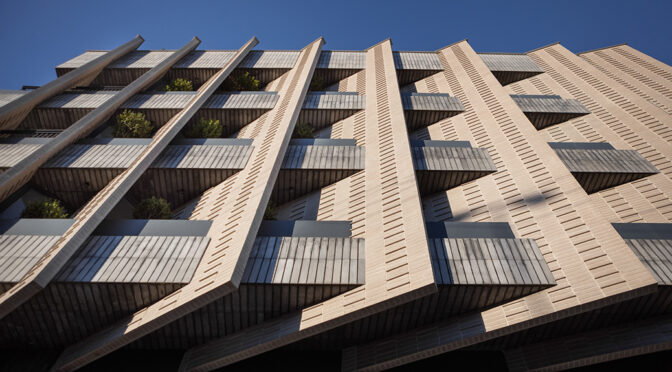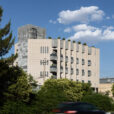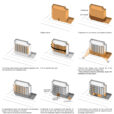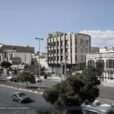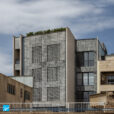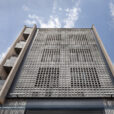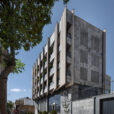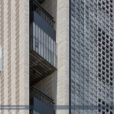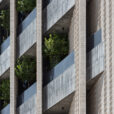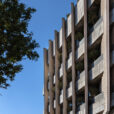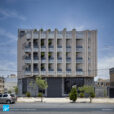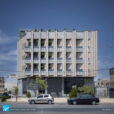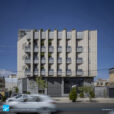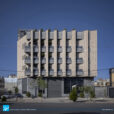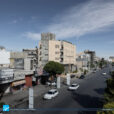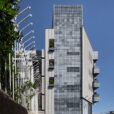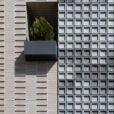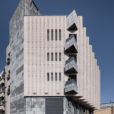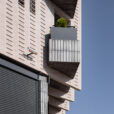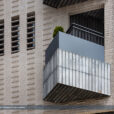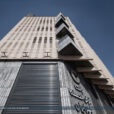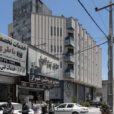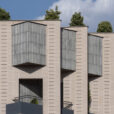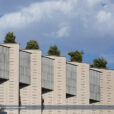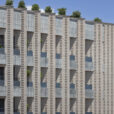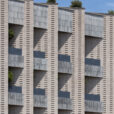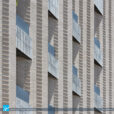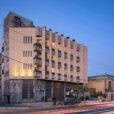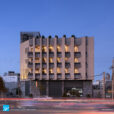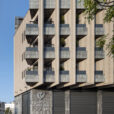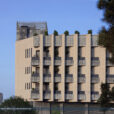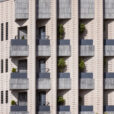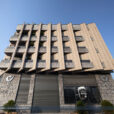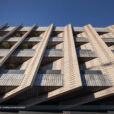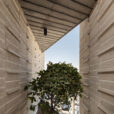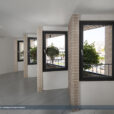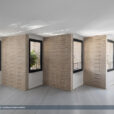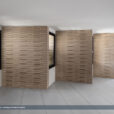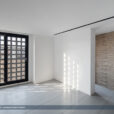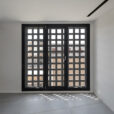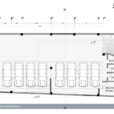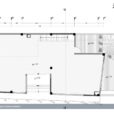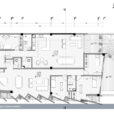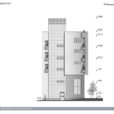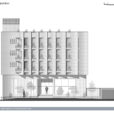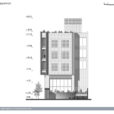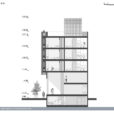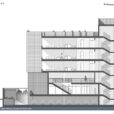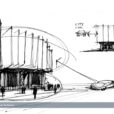آپارتمان کنارگذر
دفتر معماری اشعری و همکاران (امیرحسین اشعری)
موقعیت: شیراز، ایران
تاریخ: ۱۴۰۱
مساحت: ۱،۳۵۰ مترمربع
وضعیت: ساختهشده
کارفرما: آقای دوازدهامامی، آقای کرهانی
تیم طراحی: زهرا جعفری، افشین اشعری، احسان شبانی، زهرا رحیمی
مدلسازی سهبعدی: زهرا جعفری، احسان شبانی
هماهنگی پروژه: شیوا نظربلند، اسما سیرجانی اصل
اجرا: دفتر معماری اشعری و همکاران
گرافیک: سارا ناظمی، مطهره جوانمردی
عکس: نوید عطروش
با توجه به اینکه پروژه در مسیر ورودی غربی شیراز قرار دارد و کشیدگی آن در امتداد بلوار اصلی است، مسئله اصلی برای ما، نحوه مواجهه افراد پیاده با بخش پایین بنا، و افراد سواره با بخش بالایی بنا بود. از اینرو، استراتژی ما با در نظر گرفتن کاربری متفاوت طبقه همکف (تجاری) با بقیه طبقات (مسکونی)، این بود که بخش پایین ساختمان در سطحی که با عابران پیاده در ارتباط تنگاتنگ است، به لحاظ شکل و رنگ خنثی باشد و با کاستن از شلوغی محیط بتواند به اتصال بدنه تجاری به فضای شهری کمک کند، و در طبقات بالا نیز بر اساس زاویه دید و حرکت سوارهها، زبان متفاوتتری نسبت به بخش پایین انتخاب شود.
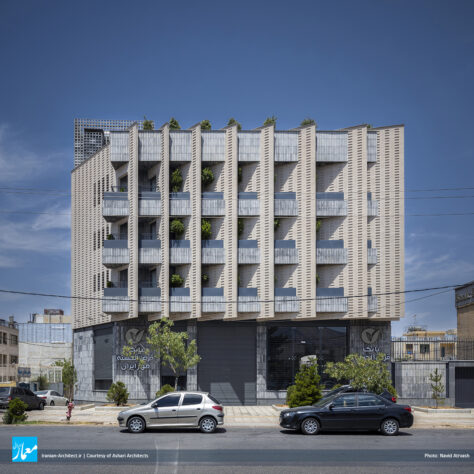
موضوع دیگر پروژه، کنترل نور مزاحم غرب بر روی بدنه اصلی بنا بود که برای این منظور، تیغههای عمودی در این نما در نظر گرفته شد. با توجه به اولویت نورگیری از سمت جنوب، این تیغهها بهصورت ریتمدار، به سمت جنوب زاویه گرفتهاند و باعث حرکت و پویایی نمای اصلی و رو به شهر پروژه میشوند. تراسهای ساختمان نیز در هر طبقه، همچون پودهایی از میان تارهای عمودی عبور میکنند و به بافت نما انسجام میبخشند.
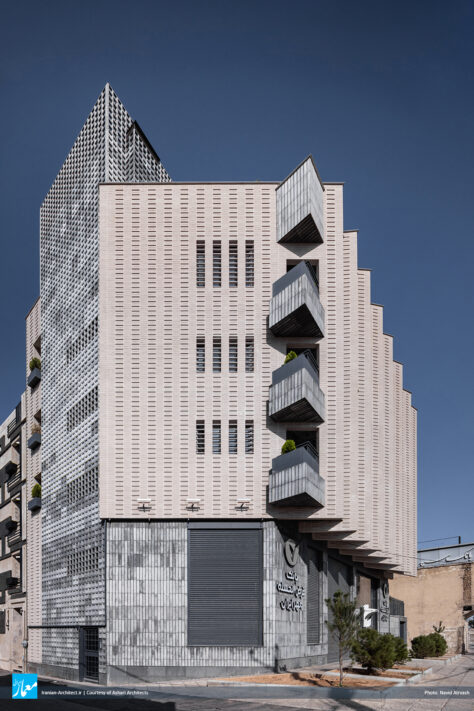
با توجه به اینکه پروژه از سمتهای مختلف دیده خواهد شد، طراحی یکپارچه جدارهها برای ما مهم بود. از اینرو، ضلعی که در پخ قرار دارد، با تیغههای نمای اصلی در یک راستا قرار گرفته است تا از دید مخاطبان سوارهای که از سمت چپ به پروژه دید دارند، نمای ضلع پخ و نمای اصلی بهصورت یکپارچه و متحد با یکدیگر دیده شوند.
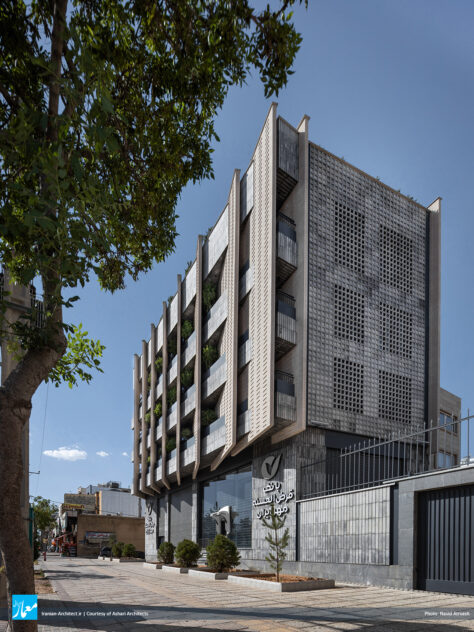
مسئله کنترل نور و دید نامناسب در نماهای شمالغربی و جنوبشرقی به شکل دیگری حل شده است. این نماها به شکل یکپارچه، با مدولهای مربع بتنی مجوف طراحی شدهاند که در عین برخورداری از یک بافت متخلخل، در کلیت ساده دیده میشوند تا توجه روی نمای اصلی همچنان حفظ شود. این مدولهای بتنی قابلیت گسترش از سمتهای مختلف را دارند و میتوانند در عین حفظ بافت برجسته روی نما، بهصورت توپر یا توخالی استفاده شوند.
Sideway Apartment
Ashari Architects (Amirhossein Ashari)
Location: Shiraz, Iran
Date: 2022
Area: 1,350 sqm
Status: Completed
Client: Mr. Davazdah Emami, Mr. Korhani
Design Team: Zahra Jafari, Afshin Ashari, Ehsan Shabani, Zahra Rahimi
3D Modeling: Zahra Jafari, Ehsan Shabani
Project Coordination: Shiva Nazarboland, Asma Sirjani Asl
Construction: Ashari Architects
Graphic: Sara Nazemi, Motahareh Javanmardi
Photo: Navid Atrvash
The project is located at the western entrance of Shiraz, and its extension is along the main boulevard. Our primary concern was how pedestrians on the lower level and riders on the upper level would engage with the building’s design. Considering the different use of the ground floor (commercial) with the upper floors (residential), our strategy focused on designing the building’s base to have a neutral appearance in both shape and color, ensuring a harmonious interaction with pedestrians and passers-by. This reduces visual clutter, fostering a seamless connection of the commercial section with the surrounding urban space. On the upper floors, taking into account the viewpoint and the movement of riders, a design language distinct from the base has been chosen.
Another concern was managing the intrusive sunlight from the west on the main body, for which vertical blades were introduced. Given the windows’ preference to draw light from the south, these blades were angled in that direction. As a result, the blades were rhythmically arranged on the main facade, imbuing it with movement and vitality as it faces the city. The terraces facing the main street, on each level, weave through the facade’s vertical strands, reminiscent of weft threads in a fabric, lending harmony to the facade’s texture.
Considering the project’s visibility from multiple external vantage points, ensuring a cohesive design across all facades was essential for us. The side situated in the chamfer aligns seamlessly with the blades. Hence, for viewers approaching the project from the left side, the chamfered facade and the main facade present themselves as an integrated and cohesive sight.
The challenge of controlling light and avoiding unsuitable visibility was addressed differently on the other sides of the facade. For the north-western and south-eastern facades, integrated designs using hollow concrete modules were implemented. While the facade boasts a porous texture, it is perceived as a simple and unified structure, ensuring that attention remains focused on the main facade. These square modules offer versatility, as they can expand in various directions. They can be utilized in either a solid or hollow state, while preserving the distinctive texture on the facade.

